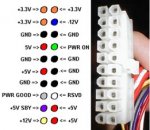Hey guys,
Been a while since my last post. Long time FreeNAS user here. So, had my 45 bay JBOD Supermicro 847 goin a while until about a year ago it broke before I flew to Seoul on business.
The story is simple. It's always had a red light and warning buzzer because something seemed to always be up with one of the PDB slots. As you may know the SM 847 has redundant psu. I have a pair of 1400w golds in there. It ran for a long time with the buzzer with both PSU in the PDB, one amber one green.
After, me, seemingly very mistakenly thinking it was a bad PSU, I replaced with a (yeah I know this was bad) a non exact matching PSU (tho the part number was the same), and I have great suspicions that the ebayer that sold me it may have sold me a bad PSU that has fried the PDB in some way.
Now when both PSU in the PDB I get two amber light, both PSU power up and self test OK amazingly, but the PDB doesn't appear to watch to switch either one of them. Now it may well just be coincidental, or the PDB got damaged more somehow when reinstalling/reinserting the new power supply I bought from ebay, right. But I have strong suspicions that the PDB has gone bad.
I'm trying to replace it, the thing is, it's a real donkeys mare to do it, and it seems like I'm missing good documentation, and couldn't find proper instructions in the manual for my specific model. I was wondering if anyone might be able to help guide me what the best way is to replace the PDB, and whether they agree with me about my diagnosis of the unfortunate condition my JBOD suffers from. I have a few arrays I'd like to get off this, and for least complications and simplicity it would be great to get my favourite disk array JBOD supermicro chassis back in action.
IF anyone has any tips about how I better I can troubleshoot the issue before replacing the PDB that would be awesome too. (please see images with comments attached).
At one point I was wondering if it was the power button, because literally everything seems dead when I press power button. Then again I'm not sure how to test that on the board, or how to replace the power button. I've tried to trace the wire and looked thru the manual for the SM 847 religiously, there just doesn't seem to be any detail about it. Sorry if the post is a bit long and stupid. It's been a while since I maintain server equipment like this. I think for the most part I'm following the correct routine, I just struggle to actually remove the PDB to try and test the replacement.
Is there anything else I could try before I replace it anyone else can think of that I may not have tried yet?
Thanks guys, I appreciate any ideas to fix my trouble with tribbles!
Best wishes,
A
Been a while since my last post. Long time FreeNAS user here. So, had my 45 bay JBOD Supermicro 847 goin a while until about a year ago it broke before I flew to Seoul on business.
The story is simple. It's always had a red light and warning buzzer because something seemed to always be up with one of the PDB slots. As you may know the SM 847 has redundant psu. I have a pair of 1400w golds in there. It ran for a long time with the buzzer with both PSU in the PDB, one amber one green.
After, me, seemingly very mistakenly thinking it was a bad PSU, I replaced with a (yeah I know this was bad) a non exact matching PSU (tho the part number was the same), and I have great suspicions that the ebayer that sold me it may have sold me a bad PSU that has fried the PDB in some way.
Now when both PSU in the PDB I get two amber light, both PSU power up and self test OK amazingly, but the PDB doesn't appear to watch to switch either one of them. Now it may well just be coincidental, or the PDB got damaged more somehow when reinstalling/reinserting the new power supply I bought from ebay, right. But I have strong suspicions that the PDB has gone bad.
I'm trying to replace it, the thing is, it's a real donkeys mare to do it, and it seems like I'm missing good documentation, and couldn't find proper instructions in the manual for my specific model. I was wondering if anyone might be able to help guide me what the best way is to replace the PDB, and whether they agree with me about my diagnosis of the unfortunate condition my JBOD suffers from. I have a few arrays I'd like to get off this, and for least complications and simplicity it would be great to get my favourite disk array JBOD supermicro chassis back in action.
IF anyone has any tips about how I better I can troubleshoot the issue before replacing the PDB that would be awesome too. (please see images with comments attached).
At one point I was wondering if it was the power button, because literally everything seems dead when I press power button. Then again I'm not sure how to test that on the board, or how to replace the power button. I've tried to trace the wire and looked thru the manual for the SM 847 religiously, there just doesn't seem to be any detail about it. Sorry if the post is a bit long and stupid. It's been a while since I maintain server equipment like this. I think for the most part I'm following the correct routine, I just struggle to actually remove the PDB to try and test the replacement.
Is there anything else I could try before I replace it anyone else can think of that I may not have tried yet?
Thanks guys, I appreciate any ideas to fix my trouble with tribbles!
Best wishes,
A











